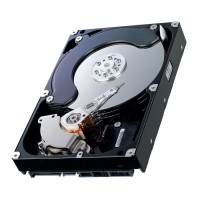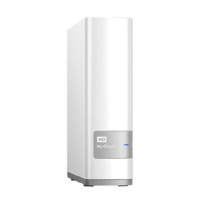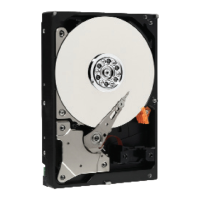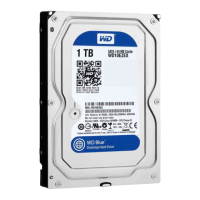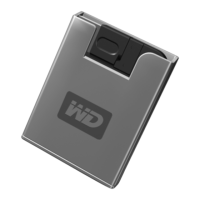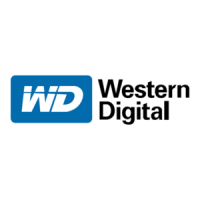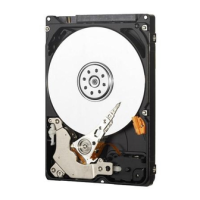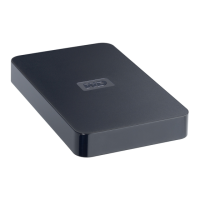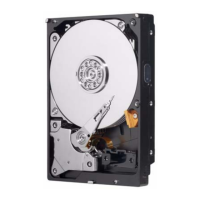Do you have a question about the Western Digital WD Series and is the answer not in the manual?
Details the WD Enterprise hard drives, their performance, capacity, interface types, and models.
Highlights key features of WD Enterprise drives, including caching, command queuing, S.M.A.R.T., and SCAM.
Provides essential precautions for unpacking and installing the WD Enterprise drive to prevent damage.
Details measures to protect the drive from electrostatic discharge (ESD) during handling.
Lists required items and optional items needed prior to installing the WD Enterprise hard drive.
Discusses constraints and requirements for securely mounting the WD Enterprise drive.
Specifies the ambient temperature limits and airflow requirements for the drive.
Describes the available mounting hole locations for the drive.
Details the type of screws, torque, and penetration depth for mounting the drive.
Explains how to configure drive settings using jumpers on the option block.
Explains how to set SCSI ID numbers using option block pins and refers to jumper settings.
Describes how to configure the drive for automatic spin-up or manual start upon power-up.
Explains the feature that delays drive start-up to prevent power surges.
Details the SCSI Configure Automatically (SCAM) option for auto ID assignment.
Explains how to configure the drive's unit attention message to the host adapter.
Describes how to disable the drive's ability to initiate synchronous/wide negotiation.
Explains the requirement for SCSI bus termination and how to enable/disable it.
Details how the drive can supply +5V to the SCSI bus for termination power.
Describes how to synchronize spindles of multiple drives to reduce latency.
Explains how to use drive pins to power an external activity LED.
Lists pins reserved for development and manufacturing purposes.
Explains how SCSI Mode Select command customizes drive characteristics.
Describes the remote option block for 68-pin drives to set IDs and options.
Provides specifications for maximum bus length and stub length based on SCSI bus type.
Describes the 50-pin SCSI connector and its compatibility.
Describes the 68-pin SCSI connector and its capabilities.
Describes the 80-pin SCA-2 connector for backplane connections.
Provides step-by-step instructions for opening a computer system chassis.
Details steps for preparing the drive, including unpacking, configuring jumpers, and checking termination.
Instructions for mounting 50-pin or 68-pin drives using mounting screws.
Instructions for mounting 80-pin drives into a drive slot and connecting to a backplane.
Steps to properly close the computer system after drive installation.
Provides formatted capacity, interface type, rotational speed, and bytes per sector for drive models.
Details MTBF, service life, and preventive maintenance for the drives.
Lists form factor, height, length, width, and weight for the drive models.
Specifies spindle start and stop times for the WD Enterprise drives.
Details typical power consumption (idle, seek) for single-ended and differential modes.
Describes power connectors and cables for 50-pin, 68-pin, and 80-pin drives.
Specifies shock resistance levels for operating and non-operating conditions.
Details vibration specifications for operating and non-operating states.
Defines temperature, humidity, and thermal gradient limits for operation.
Defines temperature, humidity, and thermal gradient limits for non-operation.
Specifies altitude ranges for operating and non-operating conditions.
Provides typical acoustic levels (idle, seek) in bels.
Provides a checklist of common issues to verify during drive installation.
States compliance with FCC Part 15 Subpart B for Class B computing devices.
States compliance with Canadian regulations for digital apparatus radio noise.
Explains the process for obtaining maintenance and returning products for service.
Details the five-year limited warranty, exclusions, and remedies for product defects.
Details the WD Enterprise hard drives, their performance, capacity, interface types, and models.
Highlights key features of WD Enterprise drives, including caching, command queuing, S.M.A.R.T., and SCAM.
Provides essential precautions for unpacking and installing the WD Enterprise drive to prevent damage.
Details measures to protect the drive from electrostatic discharge (ESD) during handling.
Lists required items and optional items needed prior to installing the WD Enterprise hard drive.
Discusses constraints and requirements for securely mounting the WD Enterprise drive.
Specifies the ambient temperature limits and airflow requirements for the drive.
Describes the available mounting hole locations for the drive.
Details the type of screws, torque, and penetration depth for mounting the drive.
Explains how to configure drive settings using jumpers on the option block.
Explains how to set SCSI ID numbers using option block pins and refers to jumper settings.
Describes how to configure the drive for automatic spin-up or manual start upon power-up.
Explains the feature that delays drive start-up to prevent power surges.
Details the SCSI Configure Automatically (SCAM) option for auto ID assignment.
Explains how to configure the drive's unit attention message to the host adapter.
Describes how to disable the drive's ability to initiate synchronous/wide negotiation.
Explains the requirement for SCSI bus termination and how to enable/disable it.
Details how the drive can supply +5V to the SCSI bus for termination power.
Describes how to synchronize spindles of multiple drives to reduce latency.
Explains how to use drive pins to power an external activity LED.
Lists pins reserved for development and manufacturing purposes.
Explains how SCSI Mode Select command customizes drive characteristics.
Describes the remote option block for 68-pin drives to set IDs and options.
Provides specifications for maximum bus length and stub length based on SCSI bus type.
Describes the 50-pin SCSI connector and its compatibility.
Describes the 68-pin SCSI connector and its capabilities.
Describes the 80-pin SCA-2 connector for backplane connections.
Provides step-by-step instructions for opening a computer system chassis.
Details steps for preparing the drive, including unpacking, configuring jumpers, and checking termination.
Instructions for mounting 50-pin or 68-pin drives using mounting screws.
Instructions for mounting 80-pin drives into a drive slot and connecting to a backplane.
Steps to properly close the computer system after drive installation.
Provides formatted capacity, interface type, rotational speed, and bytes per sector for drive models.
Details MTBF, service life, and preventive maintenance for the drives.
Lists form factor, height, length, width, and weight for the drive models.
Specifies spindle start and stop times for the WD Enterprise drives.
Details typical power consumption (idle, seek) for single-ended and differential modes.
Describes power connectors and cables for 50-pin, 68-pin, and 80-pin drives.
Specifies shock resistance levels for operating and non-operating conditions.
Details vibration specifications for operating and non-operating states.
Defines temperature, humidity, and thermal gradient limits for operation.
Defines temperature, humidity, and thermal gradient limits for non-operation.
Specifies altitude ranges for operating and non-operating conditions.
Provides typical acoustic levels (idle, seek) in bels.
Provides a checklist of common issues to verify during drive installation.
States compliance with FCC Part 15 Subpart B for Class B computing devices.
States compliance with Canadian regulations for digital apparatus radio noise.
Explains the process for obtaining maintenance and returning products for service.
Details the five-year limited warranty, exclusions, and remedies for product defects.
| Interface | SATA 6 Gb/s |
|---|---|
| Operating Temperature | 0°C to 60°C |
| Non-Operating Temperature | -40°C to 70°C |
| Capacity | 500GB, 1TB, 2TB |
| Form Factor | 3.5-inch |
| RPM | 5400 RPM, 7200 RPM |
| Cache | 64MB, 128MB |
| Application | Desktop, NAS, Surveillance |
| Workload Rate | Varies by model (typically 55TB/year to 550TB/year) |
| Power Consumption | Varies by model |
| Operating Shock | 30G |
| Non-Operating Shock | 250G |
| Acoustics | Varies by model |
| MTBF | 1, 000, 000 hours |
| Warranty | Varies (e.g., 2 years, 3 years, etc.) |
